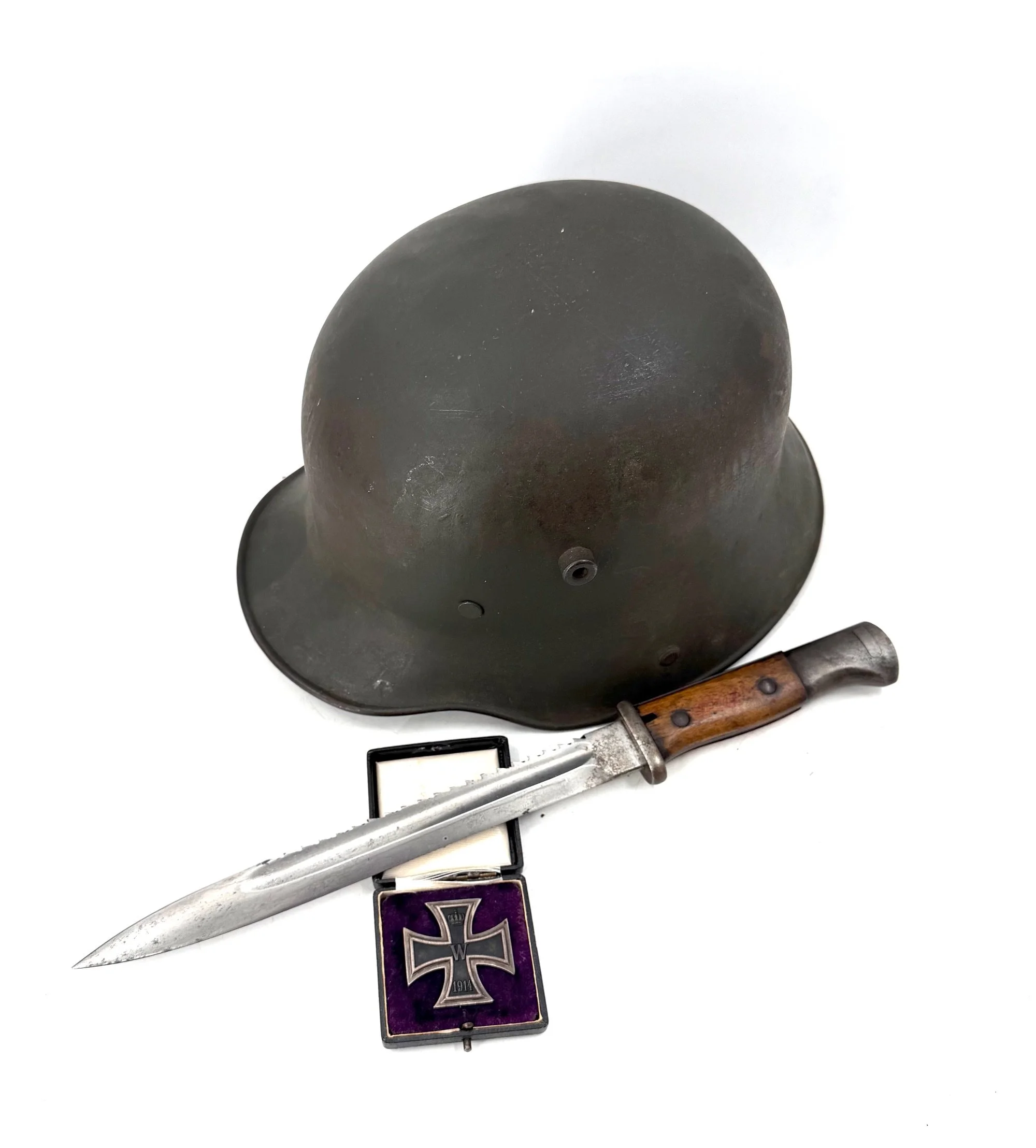Antwerp Besieged: Germany’s Path to the Western Front
German WW1 Helmet, Saw Tooth Bayonet & an Iron Cross 1st Class.
The Siege of Antwerp, conducted from 28 September to 10 October 1914, was a critical episode in the early stages of the First World War. As one of the last major fortified cities in Europe, Antwerp was both a strategic prize and a symbol of resistance for the embattled Belgian army. Its fall marked a significant step in the German advance through Belgium, shaping the course of the Western Front and influencing Allied military planning for the remainder of the war.
Following Germany’s invasion of Belgium in August 1914—part of the Schlieffen Plan to rapidly defeat France by sweeping through neutral Belgium—Antwerp gained prominence as a fallback stronghold for the Belgian government and military. While the Belgian capital, Brussels, fell on 20 August, Antwerp remained under Belgian control, housing the remnants of the national army and serving as a base for continued resistance.
Antwerp's fortifications were among the most extensive in Europe, comprising a ring of modern and semi-modern forts designed to withstand a siege. The German High Command, however, recognized that leaving such a fortress unchecked on their flank posed a serious threat to the security of their lines of communication and supply. By late September, the German Army committed to neutralizing Antwerp once and for all.
The siege officially began on 28 September 1914, when German forces under General Hans von Beseler initiated an artillery bombardment on the outer forts east and southeast of Antwerp. The German siege army numbered approximately 60,000 men, supported by heavy siege artillery, including the infamous "Big Bertha" guns and Austrian Skoda howitzers, which had already proven effective at the siege of Liège.
Despite fierce resistance, the outdated nature of many of Antwerp’s fortifications rendered them vulnerable to modern high-explosive shells. Within days, Forts Walem, Sint-Katelijne-Waver, and Lier suffered catastrophic damage, and gaps in the defensive ring began to appear. The psychological impact of sustained bombardment was immense, both for soldiers and civilians.
As Antwerp’s situation deteriorated, the British and French governments moved to support the Belgians. The British dispatched the Royal Naval Division—a hastily assembled unit of naval reservists under the command of General Archibald Paris—to reinforce the city. Arriving in early October, the unit fought bravely but could do little to reverse the tide.
By 6 October, German forces had breached the inner defensive lines. Recognizing the futility of continued resistance and the risk of encirclement, King Albert I authorized the evacuation of the Belgian field army, which successfully retreated westward toward the Yser River. The evacuation was aided by Allied forces and bought valuable time for the eventual establishment of the Yser Front, where Belgian forces would hold for the remainder of the war.
The city of Antwerp surrendered on 10 October 1914, after intense urban bombardment and mounting civilian casualties. Though the fortress had fallen, the successful withdrawal of the Belgian army was seen as a strategic success, allowing for continued resistance in western Belgium.
The fall of Antwerp had both tactical and symbolic consequences. Tactically, the Germans gained control of an important logistical hub and opened access to the Channel ports. Symbolically, however, the siege demonstrated the bravery and resilience of the Belgian military and highlighted the inadequacy of fixed fortifications against modern artillery and mobile warfare.
The siege also influenced the Allied understanding of German siege capabilities, particularly the devastating power of heavy artillery. Furthermore, the destruction of Antwerp and the displacement of tens of thousands of civilians contributed to international outrage, reinforcing support for the Allied cause, particularly in Britain.


